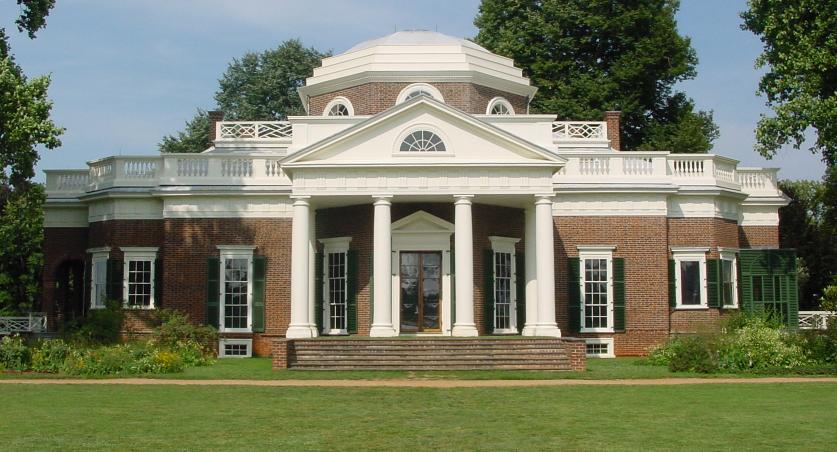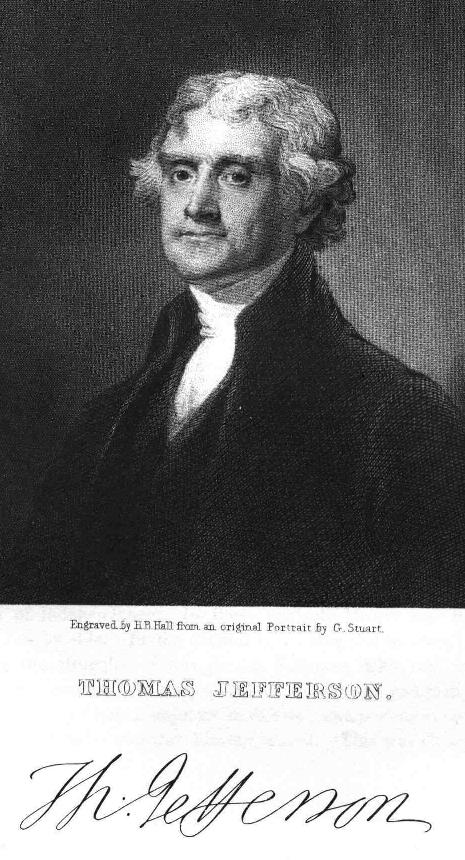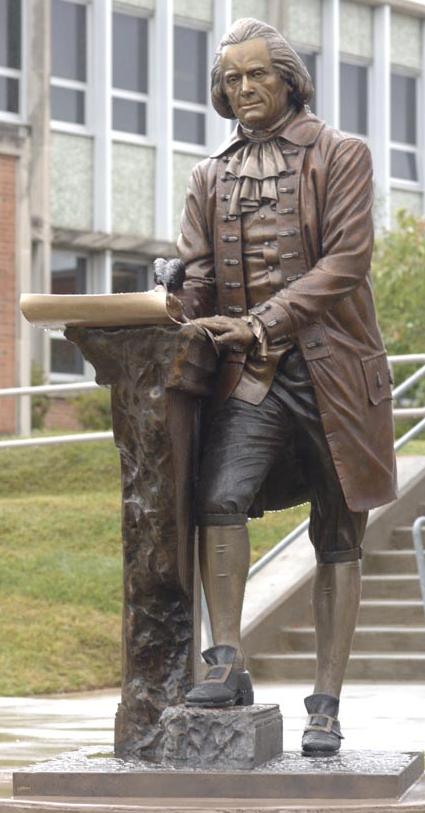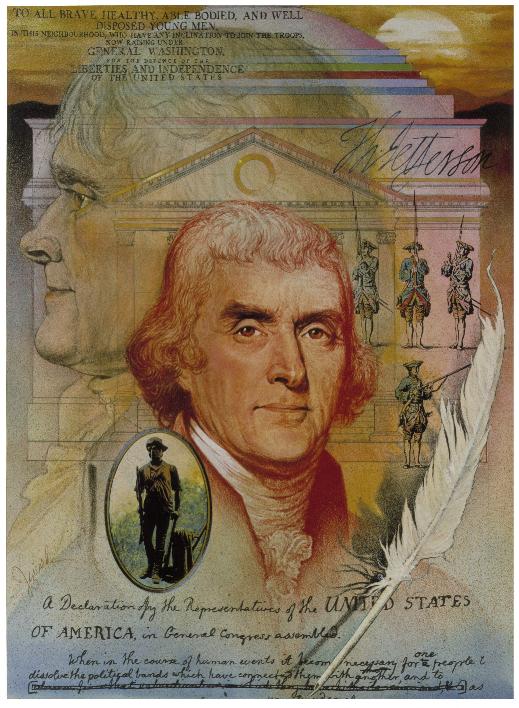| |
Home
Famous and Fascinating Women in History
Frontiersmen and Women
The World's Greatest Composers
Famous Women Spies
Great Authors of the World
Generals and other Noteworthy People
from the Civil War
The Presidents of the United States
The First Ladies of the United States
Homes and Monuments of and to
Famous People
Historical People and Events by Month for Each Day of the Year!
Famous Figures in Black History
The Calvert Family and the Lords Baltimore
Understanding the American Revolution and its People
Everything Beatles!
Everything Maryland! |
| |
|
 
|
 |  | 
Thomas
Jefferson and Monticello
By
John T. Marck

Thomas Jefferson once wrote, "All my
wishes end where I hope my days will end, at Monticello."
Monticello, in Charlottesville, Virginia
was Thomas Jefferson's home for the remaining fifty‑six years of his life.
He spent forty years designing it; building it, tearing it apart,
redesigning it, and finally putting it all back together. He loved the house
and its' property, and knew the name of every tree planted on its grounds.
And, if one of his trees died, he knew it. He used his own kilns to bake the
more than half‑million bricks he used in the various stages of its
construction.

While serving as Minister to France, he
filled almost a hundred crates with furniture and various works of art for
the many rooms at Monticello. While in France he would collect fruit trees
and bring them with him on the long boat trip home.
When Mr. Jefferson was President of the
United States, he would long for his home at Monticello. Whenever possible
he would make the long four day trip there from Washington.
After his death, practically everything
at Monticello was sold at auction. However, to celebrate his 250th birthday,
this past April, the Thomas Jefferson Memorial Foundation has done a
fantastic job in assembling various paintings, furniture, Natural History
specimens, and scientific instruments he originally collected. Additionally,
the Thomas Jefferson Memorial Foundation has, for the past eighty years,
done a magnificent job of restoring the house and its grounds. It is truly a
sight to see.
In the Foundations efforts to collect his
original property, they have amassed more than one hundred‑fifty items,
collections from museums, universities, private homes and Historical
Societies. These original items are on display at Monticello in a special
exhibition titled, "The Worlds of Thomas Jefferson at Monticello."
Some of the many items included in this
special exhibition are a collection of Native American artifacts presented
to Thomas Jefferson by Lewis & Clark; a buffalo robe; his famous
astronomical clock that he built because his old less‑accurate clocks caused
him to miss the eclipse of 1811. Also, included are his original dining
room tables; a three‑inch bell that Thomas Jefferson's wife, Martha, gave to
her nine‑year‑old slave girl, Sally Hemings; and more than thirty original
paintings. The floor of the entrance hall has been repainted the grass‑green
that it originally was, and the walls of the family sitting room have been
returned to its original indigo. These efforts to return Monticello to its
original state will provide visitors an almost exact feeling as if Thomas
Jefferson lived there today.
Thomas Jefferson picked out the site for such a house as he had planned from
his father's estate when he was twenty‑one‑years old. He named it
"Monticello" which is Italian for "Little Mountain."
Monticello was intended to be fashioned
as a traditional Palladian building, but its location was not practical. It
had been said that building a house on a mountain was most impractical. As a
result of it's impractically, Jefferson paid dearly in his efforts. He had
to transport tons of stone and timber. Once the original structure was up,
there was not enough water in the well to meet the needs. He then had to
transport water-using carts from the nearby springs.
Life was uncomfortable and difficult in
the early years of construction, especially for his wife, Martha, who had to
live in a house that in her lifetime was never finished. She had to tolerate
unfinished walls & roof, being subjected to severe cold winds, brick and
plaster dust, all the while bearing six children in ten years, having lost
four of them, until her death in 1782 at the early age of thirty‑three.
Throughout the many discomforts and
hardships experienced at Monticello, Thomas Jefferson felt there was a
brighter side, in that nothing like Monticello had ever been built in
Colonial America.
Thomas Jefferson was an extraordinary
man. In his fifty‑six years at Monticello it seems he always kept himself
quite busy. He designed and invented many things. He would start his day at
first light, reportedly when he could read the hands of the obelisk clock
that he designed. This clock was marked by clangs from a Chinese gong placed
on the roof. The gong was powered by the clock located in the entrance hall.
The mechanism was controlled by fifty-pound cannonball weights that would
descend slowly throughout the week, falling through holes in the floor by
Friday, spending the next two days falling further into the cellar.

Some of his other inventions include a
dumbwaiter; a polygraph machine that enabled him to make exact copies of
letters as he was writing them; Venetian blinds he used to regulate sunlight
in his greenhouses; a moldboard for a plow; and his achromatic telescope.
When he was not busy building, designing
or inventing, Thomas Jefferson spent many hours writing one of his more than
20,000 letters, or reading from one of his more than seven thousand books in
his library. His library contained books in seven languages, two of which
were Latin and Greek, languages he had mastered. When he worked at his desk,
he would have no less than twenty books at a time in which to refer.
Thomas Jefferson spent over forty years
in public service. He was a Delegate to the Virginia House of Burgesses
(1769‑1793); and the Continental Congress (1775); Governor of Virginia
(1797‑1801); Minister to France (1785‑1789); Washington's Secretary of State
(1789‑1793); John Adam's vice‑president (1797‑1801); and President of the
United States (1801‑1809).
Monticello through all its greatness also had an economic flaw. Although
Thomas Jefferson could feed and clothe its inhabitants, it did not produce
enough cash crops to pay for the country‑gentleman lifestyle so accustomed
to Jefferson. As a result it was worked by the most oppressive of labor
systems, human slavery. Jefferson did however deplore human slavery and was
optimistic that it would one day be abolished. He knew though that the only
way to run a plantation of this size was through the use of slaves. He did
manage to free a few of his slaves, but by the time of his death the
remaining slaves as well as the remainder of his property were offered for
sale to pay his debts.
Throughout his lifetime Thomas Jefferson
is remembered for his wit, his designs and inventions, his writings, and his
public service. But let us not forget that it was he who wrote the
Declaration of Independence and also as President of the United States
signed the authorization for the Louisiana Purchase, thus acquiring for the
United States what is now the present states of Louisiana, Arkansas,
Missouri, Iowa, Minnesota, North and South Dakota, Nebraska, Kansas,
Oklahoma, Wyoming and Montana. This was perhaps the most endearing service
to his country.
I have had the privilege to visit
Monticello on two separate occasions. It is an experience one would never
forget. I recommend a visit to all.
Thomas Jefferson: Born April 13th, 1743. Thomas Jefferson wrote in his
account book in 1826 the inscriptions to be cut on his tombstone. He made no
note that he had been President of the United States, but wished simply to
be most remembered for founding the University of Virginia, for writing the
Declaration of Independence and Virginia's Act for Religious Freedom. The
last line was to read: Died July 4, 1826.
It was only fitting that Thomas Jefferson
died at Monticello, the place he loved to live.

Statue of Thomas Jefferson at the University of Virginia
at Wise
Quick
Biographical Facts
THOMAS
JEFFERSON
3rd President of the
United States
Term‑March 4, 1801 to
March 4, 1809
Democratic‑Republican
Party

Birth:
"Shadwell", Goochland (now Albemarle) County, Virginia, April 13, 1743.
Ancestry:
Welsh
Marriage:
"The Forest" Charles City, County, Virginia January 1, 1772 to Martha Wayles
Skelton who was born in Charles City, County, Virginia October 19, 1748.
Martha died on September 6, 1782 at "Monticello", Virginia and is buried
there.
Children:
Martha (1772‑1836); Maria (1778‑1804); Lucy Elizabeth (1782‑1785). (Two
daughters and a son died in infancy).
Home:
"Monticello", Charlottesville, Virginia.
Education:
Private Tutoring; Attended country school in Albemarle County, Virginia;
Received B.A. from College of William and Mary.
Religion:
No specific denomination.
Occupation before Presidency:
Planter, lawyer, writer, philosopher, scientist, architect.
Pre‑Presidential Offices:
Member of Virginia House of Burgesses; County Lieutenant; County Surveyor;
Deputy Delegate to Second Continental Congress; Member of Virginia House of
Delegates; Governor of Virginia; Commissioner to France; Minister to France;
Secretary of State; Vice‑President.
Age at Inauguration:
57
First Administration:
Vice‑President: Aaron Burr of New York. Inauguration March 4, 1801, Senate
Chambers, Washington D.C.
Second Administration:
Vice‑President: George Clinton of New York. Inauguration March 4, 1805,
Senate Chamber, Washington, D.C.
Occupation after Presidency:
Planter, writer, educator.
Death:
"Monticello", Charlottesville, Virginia, July 4, 1826.
Cause of Death:
Diarrhea, age 83.
Place of Burial:
"Monticello", Charlottesville, Virginia.
Fascinating Facts:
·
Jefferson wrote the Declaration of Independence and Virginia's Act for
Religious Freedom.
·
He
designed and invented clocks, a dumbwaiter, a polygraph machine, Venetian
blinds, a moldboard for a plow and his achromatic telescope.
·
Although
the third President of the U.S., Jefferson was the first man to hold the
cabinet position of Secretary of State.
·
In
December 1795, Jefferson planted 1,151 peach trees at his Monticello estate.
·
When
Jefferson became President, the population of the U.S. was 5.3 million.

Thomas Jefferson Poster from the Virginia National Guard
Copyright © by John T. Marck. All Rights
Reserved. This article may not be resold, reprinted, or redistributed for
compensation of any kind without prior written permission from the author.
Information also from “The Presidents of the United States," by John T.
Marck, and “The First Ladies of the United States,” by John T. Marck.
A
Splendid Time Is Guaranteed For All
| | |
| |

